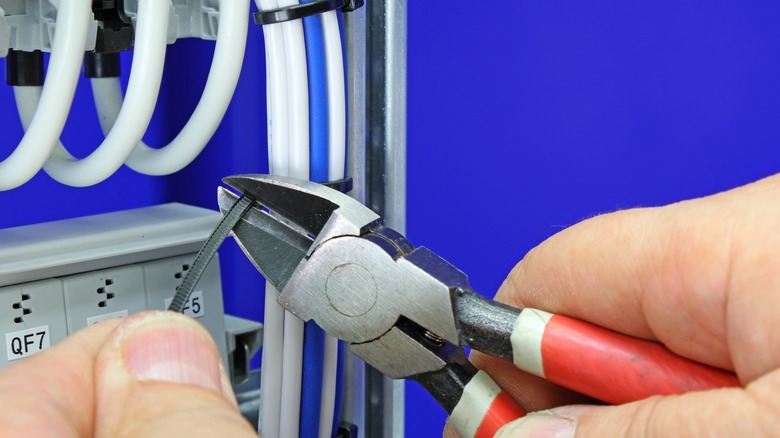Extend The Life Of Your Wire Cutters With This Sharpening Method
Wire cutters, and pliers with the hidden feature that lets them slice through cables, undergo a great deal of abuse if you regularly put them to work cutting metal. After all, biting through a tough material like metal is no easy feat, and long-term use can wear the blades out. If you're finding that your pair of cutters just isn't up to the task of cutting through metal wire, it's possible that the nut joining the two blades and enabling them to pivot is loose; this flaw may prevent the tool from cutting as it's meant to. However, if the nut is securely tightened, and the material you're cutting isn't too thick for your tool, chances are the cutters' blades are worn out and dull. Fortunately, there's a simple way to prolong your wire cutters' useful lifespan — all you need to do is sharpen them with a file.
The procedure is straightforward, and similar to the method for sharpening your garden shears. That said, you'll need to make sure that you have the right tools for the job. If you have a large pair of cutters that need urgent rescuing, you'll have to use a larger file (circular ones work well). You'll also need a vise at your workstation to help you get the job done. On the other hand, a smaller pair of cutters can be sharpened quickly with your hands — no vise required. Below, we'll walk you through the steps for sharpening wire cutters large and small so you can get the blades working again perfectly.
Steps for sharpening wire cutters with a file
Start by selecting a well-lit area so you can see all the dents and imperfections on the wire cutters' blades. Before you begin, don key protective gear to prevent accidental injury. Any workstation where you're sharpening tools is an important place to wear safety goggles and gloves.
How you stabilize the wire cutters for the sharpening process depends on their size. Smaller ones are easy — you hold the cutters in your non-dominant hand, then use the dominant hand to maneuver the file as you sharpen. On the other hand, large, heavy-duty cutters should be clamped tightly in a vise, with the blades open.
Whether you're holding the cutters or clamping them in a vise, you can start sharpening by moving the file firmly downward and along the beveled edge of the blade. You'll have to repeat the motion multiple times before the edge becomes sharp enough. If you're seeing dents or other defects on the blade's edge, keep on working until they're filed away. There's no need to make the wire cutters razor-sharp — especially if you're dealing with a heavy-duty pair that's never used for finer tasks. That said, if you're after an edge that's sharp enough to sculpt your beard, upgrade the file to a finer grit and have a few more passes on the blade. For the sake of consistency, make sure you're dragging the file the same number of times across both blades. When you think you're done, test the wire cutters out and confirm that they're sharp enough for the job.
